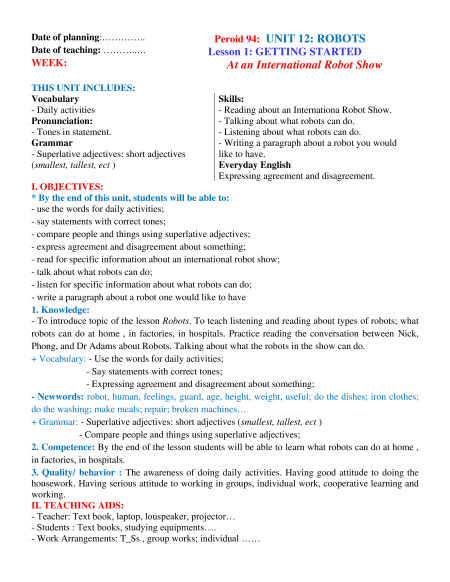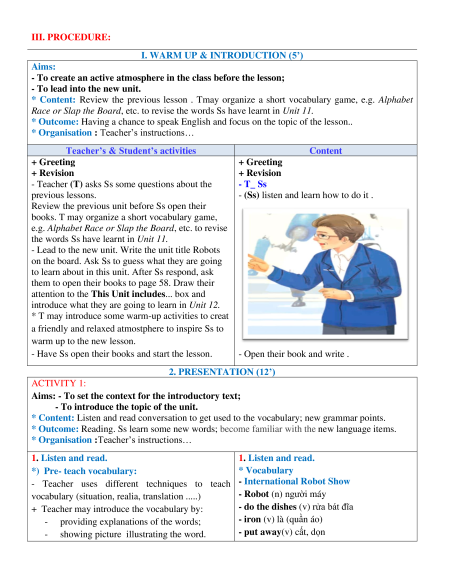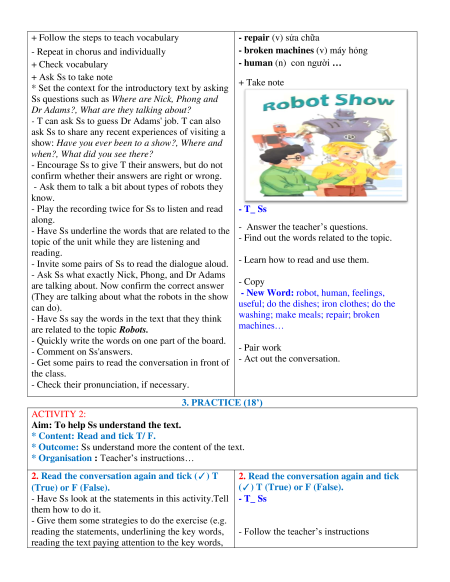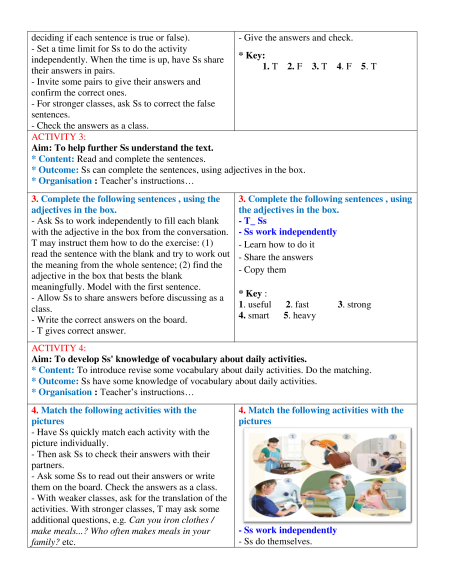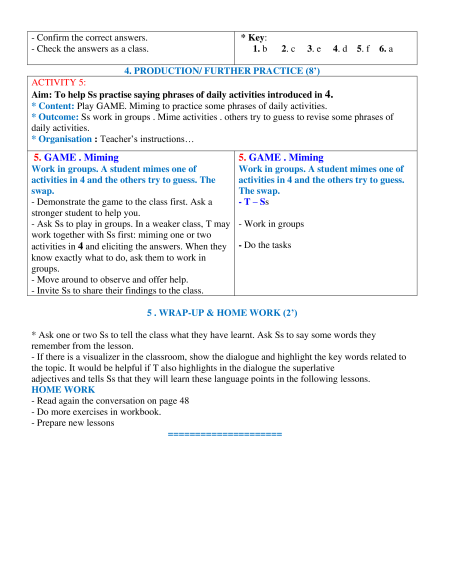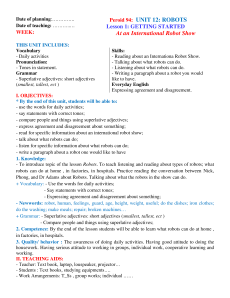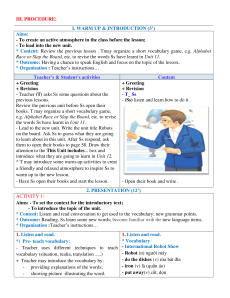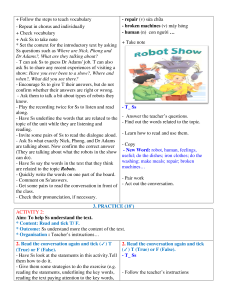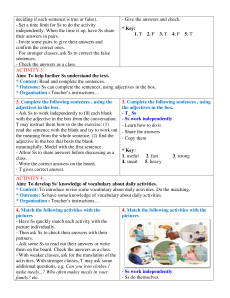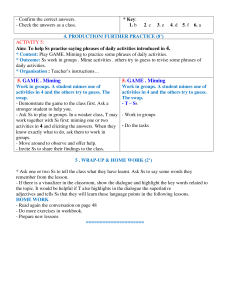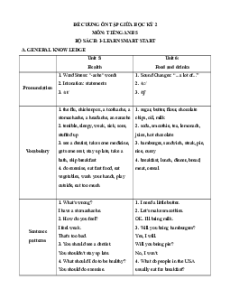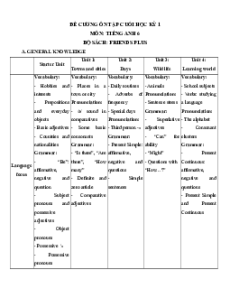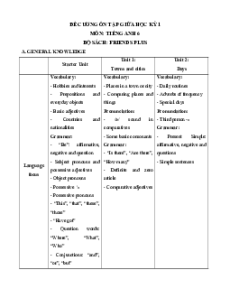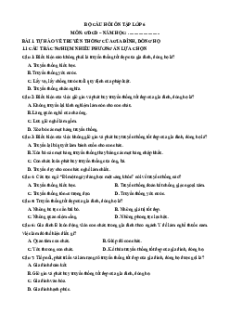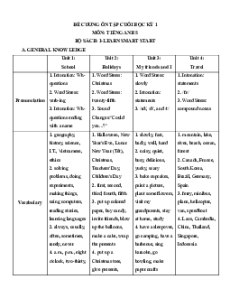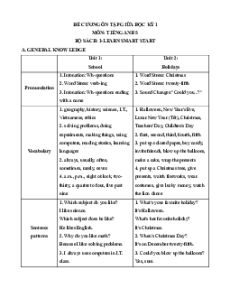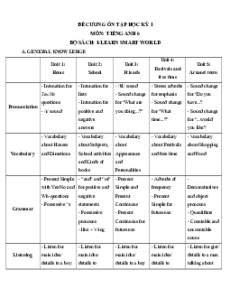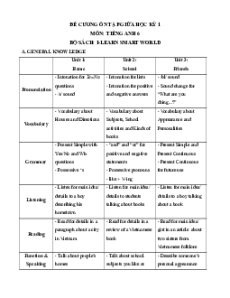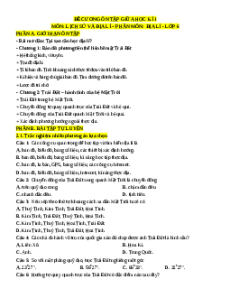Date of planning:…………..
Peroid 94: UNIT 12: ROBOTS
Date of teaching: ………..…
Lesson 1: GETTING STARTED WEEK:
At an International Robot Show
THIS UNIT INCLUDES: Vocabulary Skills: - Daily activities
- Reading about an Internationa Robot Show. Pronunciation:
- Talking about what robots can do. - Tones in statement.
- Listening about what robots can do. Grammar
- Writing a paragraph about a robot you would
- Superlative adjectives: short adjectives like to have.
(smallest, tallest, ect ) Everyday English
Expressing agreement and disagreement. I. OBJECTIVES:
* By the end of this unit, students will be able to:
- use the words for daily activities;
- say statements with correct tones;
- compare people and things using superlative adjectives;
- express agreement and disagreement about something;
- read for specific information about an international robot show;
- talk about what robots can do;
- listen for specific information about what robots can do;
- write a paragraph about a robot one would like to have 1. Knowledge:
- To introduce topic of the lesson Robots. To teach listening and reading about types of robots; what
robots can do at home , in factories, in hospitals. Practice reading the conversation between Nick,
Phong, and Dr Adams about Robots. Talking about what the robots in the show can do.
+ Vocabulary: - Use the words for daily activities;
- Say statements with correct tones;
- Expressing agreement and disagreement about something;
- Newwords: robot, human, feelings, guard, age, height, weight, useful; do the dishes; iron clothes;
do the washing; make meals; repair; broken machines…
+ Grammar: - Superlative adjectives: short adjectives (smallest, tallest, ect )
- Compare people and things using superlative adjectives;
2. Competence: By the end of the lesson students will be able to learn what robots can do at home , in factories, in hospitals.
3. Quality/ behavior : The awareness of doing daily activities. Having good attitude to doing the
housework. Having serious attitude to working in groups, individual work, cooperative learning and working. II. TEACHING AIDS:
- Teacher: Text book, laptop, louspeaker, projector…
- Students : Text books, studying equipments….
- Work Arrangements: T_Ss , group works; individual …… III. PROCEDURE:
I. WARM UP & INTRODUCTION (5’) Aims:
- To create an active atmosphere in the class before the lesson; - To lead into the new unit.
* Content: Review the previous lesson . Tmay organize a short vocabulary game, e.g. Alphabet
Race or Slap the Board, etc. to revise the words Ss have learnt in Unit 11.
* Outcome: Having a chance to speak English and focus on the topic of the lesson..
* Organisation : Teacher’s instructions…
Teacher’s & Student’s activities Content + Greeting + Greeting + Revision + Revision
- Teacher (T) asks Ss some questions about the - T_ Ss previous lessons.
- (Ss) listen and learn how to do it .
Review the previous unit before Ss open their
books. T may organize a short vocabulary game,
e.g. Alphabet Race or Slap the Board, etc. to revise
the words Ss have learnt in Unit 11.
- Lead to the new unit. Write the unit title Robots
on the board. Ask Ss to guess what they are going
to learn about in this unit. After Ss respond, ask
them to open their books to page 58. Draw their
attention to the This Unit includes... box and
introduce what they are going to learn in Unit 12.
* T may introduce some warm-up activities to creat
a friendly and relaxed atmostphere to inspire Ss to warm up to the new lesson.
- Have Ss open their books and start the lesson.
- Open their book and write .
2. PRESENTATION (12’) ACTIVITY 1:
Aims: - To set the context for the introductory text;
- To introduce the topic of the unit.
* Content: Listen and read conversation to get used to the vocabulary; new grammar points.
* Outcome: Reading. Ss learn some new words; become familiar with the new language items.
* Organisation :Teacher’s instructions… 1. Listen and read. 1. Listen and read.
*) Pre- teach vocabulary: * Vocabulary
- Teacher uses different techniques to teach - International Robot Show
vocabulary (situation, realia, translation .....)
- Robot (n) người máy
+ Teacher may introduce the vocabulary by:
- do the dishes (v) rửa bát đĩa
- providing explanations of the words;
- iron (v) là (quần áo)
- showing picture illustrating the word.
- put away(v) cất, dọn
+ Follow the steps to teach vocabulary
- repair (v) sửa chữa
- Repeat in chorus and individually
- broken machines (v) máy hỏng + Check vocabulary
- human (n) con người … + Ask Ss to take note + Take note
* Set the context for the introductory text by asking
Ss questions such as Where are Nick, Phong and
Dr Adams?, What are they talking about?
- T can ask Ss to guess Dr Adams' job. T can also
ask Ss to share any recent experiences of visiting a
show: Have you ever been to a show?, Where and
when?, What did you see there?
- Encourage Ss to give T their answers, but do not
confirm whether their answers are right or wrong.
- Ask them to talk a bit about types of robots they know.
- Play the recording twice for Ss to listen and read - T_ Ss along.
- Have Ss underline the words that are related to the - Answer the teacher’s questions.
topic of the unit while they are listening and
- Find out the words related to the topic. reading.
- Invite some pairs of Ss to read the dialogue aloud. - Learn how to read and use them.
- Ask Ss what exactly Nick, Phong, and Dr Adams
are talking about. Now confirm the correct answer - Copy
(They are talking about what the robots in the show - New Word: robot, human, feelings, can do).
useful; do the dishes; iron clothes; do the
- Have Ss say the words in the text that they think
washing; make meals; repair; broken machines…
are related to the topic Robots.
- Quickly write the words on one part of the board. - Comment on Ss'answers. - Pair work
- Get some pairs to read the conversation in front of - Act out the conversation. the class.
- Check their pronunciation, if necessary. 3. PRACTICE (18’) ACTIVITY 2:
Aim: To help Ss understand the text.
* Content: Read and tick T/ F.
* Outcome: Ss understand more the content of the text.
* Organisation : Teacher’s instructions…
2. Read the conversation again and tick (✓) T
2. Read the conversation again and tick (True) or F (False).
(✓) T (True) or F (False).
- Have Ss look at the statements in this activity.Tell - T_ Ss them how to do it.
- Give them some strategies to do the exercise (e.g.
reading the statements, underlining the key words,
- Follow the teacher’s instructions
reading the text paying attention to the key words,
deciding if each sentence is true or false). - Give the answers and check.
- Set a time limit for Ss to do the activity
independently. When the time is up, have Ss share * Key: their answers in pairs.
1. T 2. F 3. T 4. F 5. T
- Invite some pairs to give their answers and confirm the correct ones.
- For stronger classes, ask Ss to correct the false sentences.
- Check the answers as a class. ACTIVITY 3:
Aim: To help further Ss understand the text.
* Content: Read and complete the sentences.
* Outcome: Ss can complete the sentences, using adjectives in the box.
* Organisation : Teacher’s instructions…
3. Complete the following sentences , using the
3. Complete the following sentences , using adjectives in the box.
the adjectives in the box.
- Ask Ss to work independently to fill each blank - T_ Ss
with the adjective in the box from the conversation. - Ss work independently
T may instruct them how to do the exercise: (1) - Learn how to do it
read the sentence with the blank and try to work out - Share the answers
the meaning from the whole sentence; (2) find the - Copy them
adjective in the box that bests the blank
meaningfully. Model with the first sentence. * Key :
- Allow Ss to share answers before discussing as a
1. useful 2. fast 3. strong class.
4. smart 5. heavy
- Write the correct answers on the board. - T gives correct answer. ACTIVITY 4:
Aim: To develop Ss' knowledge of vocabulary about daily activities.
* Content: To introduce revise some vocabulary about daily activities. Do the matching.
* Outcome: Ss have some knowledge of vocabulary about daily activities.
* Organisation : Teacher’s instructions…
4. Match the following activities with the
4. Match the following activities with the pictures pictures
- Have Ss quickly match each activity with the picture individually.
- Then ask Ss to check their answers with their partners.
- Ask some Ss to read out their answers or write
them on the board. Check the answers as a class.
- With weaker classes, ask for the translation of the
activities. With stronger classes, T may ask some
additional questions, e.g. Can you iron clothes /
make meals...? Who often makes meals in your
- Ss work independently family? etc. - Ss do themselves.
Giáo án Unit 12: Robots Tiếng Anh 6 Global success
0.9 K
453 lượt tải
MUA NGAY ĐỂ XEM TOÀN BỘ TÀI LIỆU
CÁCH MUA:
- B1: Gửi phí vào TK:
1133836868- CT TNHH DAU TU VA DV GD VIETJACK - Ngân hàng MB (QR) - B2: Nhắn tin tới Zalo VietJack Official ( nhấn vào đây ) để xác nhận thanh toán và tải tài liệu - giáo án
Liên hệ ngay Hotline hỗ trợ: 084 283 45 85
Bộ giáo án Tiếng anh 6 Global success được cập nhật liên tục trong gói này từ nay đến hết tháng 3/2024.
Để tải tài liệu gốc về máy bạn click vào nút Tải Xuống ở trên!
Thuộc bộ (mua theo bộ để tiết kiệm hơn):
- Bộ giáo án Tiếng anh 6 Global success năm 2023 mới, chuẩn nhất được thiết kế theo phong cách hiện đại, đẹp mắt, trình bày chi tiết cho từng bài học và bám sát chương trình Sách giáo khoa Tiếng anh 6 Global success.
- Mua trọn bộ sẽ tiết kiệm hơn tải lẻ 50%.
Đánh giá
4.6 / 5(905 )5
4
3
2
1
Trọng Bình
Tài liệu hay
Giúp ích cho tôi rất nhiều
Duy Trần
Tài liệu chuẩn
Rất thích tài liệu bên VJ soạn (bám sát chương trình dạy)
TÀI LIỆU BỘ BÁN CHẠY MÔN Tiếng Anh
Xem thêmTÀI LIỆU BỘ BÁN CHẠY Lớp 6
Xem thêmTài liệu bộ mới nhất

Date of planning:…………..
Date of teaching: ………..…
WEEK:
Peroid 94: UNIT 12: ROBOTS
Lesson 1: GETTING STARTED
At an International Robot Show
THIS UNIT INCLUDES:
Vocabulary
- Daily activities
Pronunciation:
- Tones in statement.
Grammar
- Superlative adjectives: short adjectives
(smallest, tallest, ect )
Skills:
- Reading about an Internationa Robot Show.
- Talking about what robots can do.
- Listening about what robots can do.
- Writing a paragraph about a robot you would
like to have.
Everyday English
Expressing agreement and disagreement.
I. OBJECTIVES:
* By the end of this unit, students will be able to:
- use the words for daily activities;
- say statements with correct tones;
- compare people and things using superlative adjectives;
- express agreement and disagreement about something;
- read for specific information about an international robot show;
- talk about what robots can do;
- listen for specific information about what robots can do;
- write a paragraph about a robot one would like to have
1. Knowledge:
- To introduce topic of the lesson Robots. To teach listening and reading about types of robots; what
robots can do at home , in factories, in hospitals. Practice reading the conversation between Nick,
Phong, and Dr Adams about Robots. Talking about what the robots in the show can do.
+ Vocabulary: - Use the words for daily activities;
- Say statements with correct tones;
- Expressing agreement and disagreement about something;
- Newwords: robot, human, feelings, guard, age, height, weight, useful; do the dishes; iron clothes;
do the washing; make meals; repair; broken machines…
+ Grammar: - Superlative adjectives: short adjectives (smallest, tallest, ect )
- Compare people and things using superlative adjectives;
2. Competence: By the end of the lesson students will be able to learn what robots can do at home ,
in factories, in hospitals.
3. Quality/ behavior : The awareness of doing daily activities. Having good attitude to doing the
housework. Having serious attitude to working in groups, individual work, cooperative learning and
working.
II. TEACHING AIDS:
- Teacher: Text book, laptop, louspeaker, projector…
- Students : Text books, studying equipments….
- Work Arrangements: T_Ss , group works; individual ……

III. PROCEDURE:
I. WARM UP & INTRODUCTION (5’)
Aims:
- To create an active atmosphere in the class before the lesson;
- To lead into the new unit.
* Content: Review the previous lesson . Tmay organize a short vocabulary game, e.g. Alphabet
Race or Slap the Board, etc. to revise the words Ss have learnt in Unit 11.
* Outcome: Having a chance to speak English and focus on the topic of the lesson..
* Organisation : Teacher’s instructions…
Teacher’s & Student’s activities
Content
+ Greeting
+ Revision
- Teacher (T) asks Ss some questions about the
previous lessons.
Review the previous unit before Ss open their
books. T may organize a short vocabulary game,
e.g. Alphabet Race or Slap the Board, etc. to revise
the words Ss have learnt in Unit 11.
- Lead to the new unit. Write the unit title Robots
on the board. Ask Ss to guess what they are going
to learn about in this unit. After Ss respond, ask
them to open their books to page 58. Draw their
attention to the This Unit includes... box and
introduce what they are going to learn in Unit 12.
* T may introduce some warm-up activities to creat
a friendly and relaxed atmostphere to inspire Ss to
warm up to the new lesson.
- Have Ss open their books and start the lesson.
+ Greeting
+ Revision
- T_ Ss
- (Ss) listen and learn how to do it .
- Open their book and write .
2. PRESENTATION (12’)
ACTIVITY 1:
Aims: - To set the context for the introductory text;
- To introduce the topic of the unit.
* Content: Listen and read conversation to get used to the vocabulary; new grammar points.
* Outcome: Reading. Ss learn some new words; become familiar with the new language items.
* Organisation :Teacher’s instructions…
1. Listen and read.
*) Pre- teach vocabulary:
- Teacher uses different techniques to teach
vocabulary (situation, realia, translation .....)
+ Teacher may introduce the vocabulary by:
- providing explanations of the words;
- showing picture illustrating the word.
1. Listen and read.
* Vocabulary
- International Robot Show
- Robot (n) người máy
- do the dishes (v) rửa bát đĩa
- iron (v) là (quần áo)
- put away(v) cất, dọn

+ Follow the steps to teach vocabulary
- Repeat in chorus and individually
+ Check vocabulary
+ Ask Ss to take note
* Set the context for the introductory text by asking
Ss questions such as Where are Nick, Phong and
Dr Adams?, What are they talking about?
- T can ask Ss to guess Dr Adams' job. T can also
ask Ss to share any recent experiences of visiting a
show: Have you ever been to a show?, Where and
when?, What did you see there?
- Encourage Ss to give T their answers, but do not
confirm whether their answers are right or wrong.
- Ask them to talk a bit about types of robots they
know.
- Play the recording twice for Ss to listen and read
along.
- Have Ss underline the words that are related to the
topic of the unit while they are listening and
reading.
- Invite some pairs of Ss to read the dialogue aloud.
- Ask Ss what exactly Nick, Phong, and Dr Adams
are talking about. Now confirm the correct answer
(They are talking about what the robots in the show
can do).
- Have Ss say the words in the text that they think
are related to the topic Robots.
- Quickly write the words on one part of the board.
- Comment on Ss'answers.
- Get some pairs to read the conversation in front of
the class.
- Check their pronunciation, if necessary.
- repair (v) sửa chữa
- broken machines (v) máy hỏng
- human (n) con người …
+ Take note
- T_ Ss
- Answer the teacher’s questions.
- Find out the words related to the topic.
- Learn how to read and use them.
- Copy
- New Word: robot, human, feelings,
useful; do the dishes; iron clothes; do the
washing; make meals; repair; broken
machines…
- Pair work
- Act out the conversation.
3. PRACTICE (18’)
ACTIVITY 2:
Aim: To help Ss understand the text.
* Content: Read and tick T/ F.
* Outcome: Ss understand more the content of the text.
* Organisation : Teacher’s instructions…
2. Read the conversation again and tick (✓) T
(True) or F (False).
- Have Ss look at the statements in this activity.Tell
them how to do it.
- Give them some strategies to do the exercise (e.g.
reading the statements, underlining the key words,
reading the text paying attention to the key words,
2. Read the conversation again and tick
(✓) T (True) or F (False).
- T_ Ss
- Follow the teacher’s instructions

deciding if each sentence is true or false).
- Set a time limit for Ss to do the activity
independently. When the time is up, have Ss share
their answers in pairs.
- Invite some pairs to give their answers and
confirm the correct ones.
- For stronger classes, ask Ss to correct the false
sentences.
- Check the answers as a class.
- Give the answers and check.
* Key:
1. T 2. F 3. T 4. F 5. T
ACTIVITY 3:
Aim: To help further Ss understand the text.
* Content: Read and complete the sentences.
* Outcome: Ss can complete the sentences, using adjectives in the box.
* Organisation : Teacher’s instructions…
3. Complete the following sentences , using the
adjectives in the box.
- Ask Ss to work independently to fill each blank
with the adjective in the box from the conversation.
T may instruct them how to do the exercise: (1)
read the sentence with the blank and try to work out
the meaning from the whole sentence; (2) find the
adjective in the box that bests the blank
meaningfully. Model with the first sentence.
- Allow Ss to share answers before discussing as a
class.
- Write the correct answers on the board.
- T gives correct answer.
3. Complete the following sentences , using
the adjectives in the box.
- T_ Ss
- Ss work independently
- Learn how to do it
- Share the answers
- Copy them
* Key :
1. useful 2. fast 3. strong
4. smart 5. heavy
ACTIVITY 4:
Aim: To develop Ss' knowledge of vocabulary about daily activities.
* Content: To introduce revise some vocabulary about daily activities. Do the matching.
* Outcome: Ss have some knowledge of vocabulary about daily activities.
* Organisation : Teacher’s instructions…
4. Match the following activities with the
pictures
- Have Ss quickly match each activity with the
picture individually.
- Then ask Ss to check their answers with their
partners.
- Ask some Ss to read out their answers or write
them on the board. Check the answers as a class.
- With weaker classes, ask for the translation of the
activities. With stronger classes, T may ask some
additional questions, e.g. Can you iron clothes /
make meals...? Who often makes meals in your
family? etc.
4. Match the following activities with the
pictures
- Ss work independently
- Ss do themselves.

- Confirm the correct answers.
- Check the answers as a class.
* Key:
1. b 2. c 3. e 4. d 5. f 6. a
4. PRODUCTION/ FURTHER PRACTICE (8’)
ACTIVITY 5:
Aim: To help Ss practise saying phrases of daily activities introduced in 4.
* Content: Play GAME. Miming to practice some phrases of daily activities.
* Outcome: Ss work in groups . Mime activities . others try to guess to revise some phrases of
daily activities.
* Organisation : Teacher’s instructions…
5. GAME . Miming
Work in groups. A student mimes one of
activities in 4 and the others try to guess. The
swap.
- Demonstrate the game to the class first. Ask a
stronger student to help you.
- Ask Ss to play in groups. In a weaker class, T may
work together with Ss first: miming one or two
activities in 4 and eliciting the answers. When they
know exactly what to do, ask them to work in
groups.
- Move around to observe and offer help.
- Invite Ss to share their findings to the class.
5. GAME . Miming
Work in groups. A student mimes one of
activities in 4 and the others try to guess.
The swap.
- T – Ss
- Work in groups
- Do the tasks
5 . WRAP-UP & HOME WORK (2’)
* Ask one or two Ss to tell the class what they have learnt. Ask Ss to say some words they
remember from the lesson.
- If there is a visualizer in the classroom, show the dialogue and highlight the key words related to
the topic. It would be helpful if T also highlights in the dialogue the superlative
adjectives and tells Ss that they will learn these language points in the following lessons.
HOME WORK
- Read again the conversation on page 48
- Do more exercises in workbook.
- Prepare new lessons
=====================
